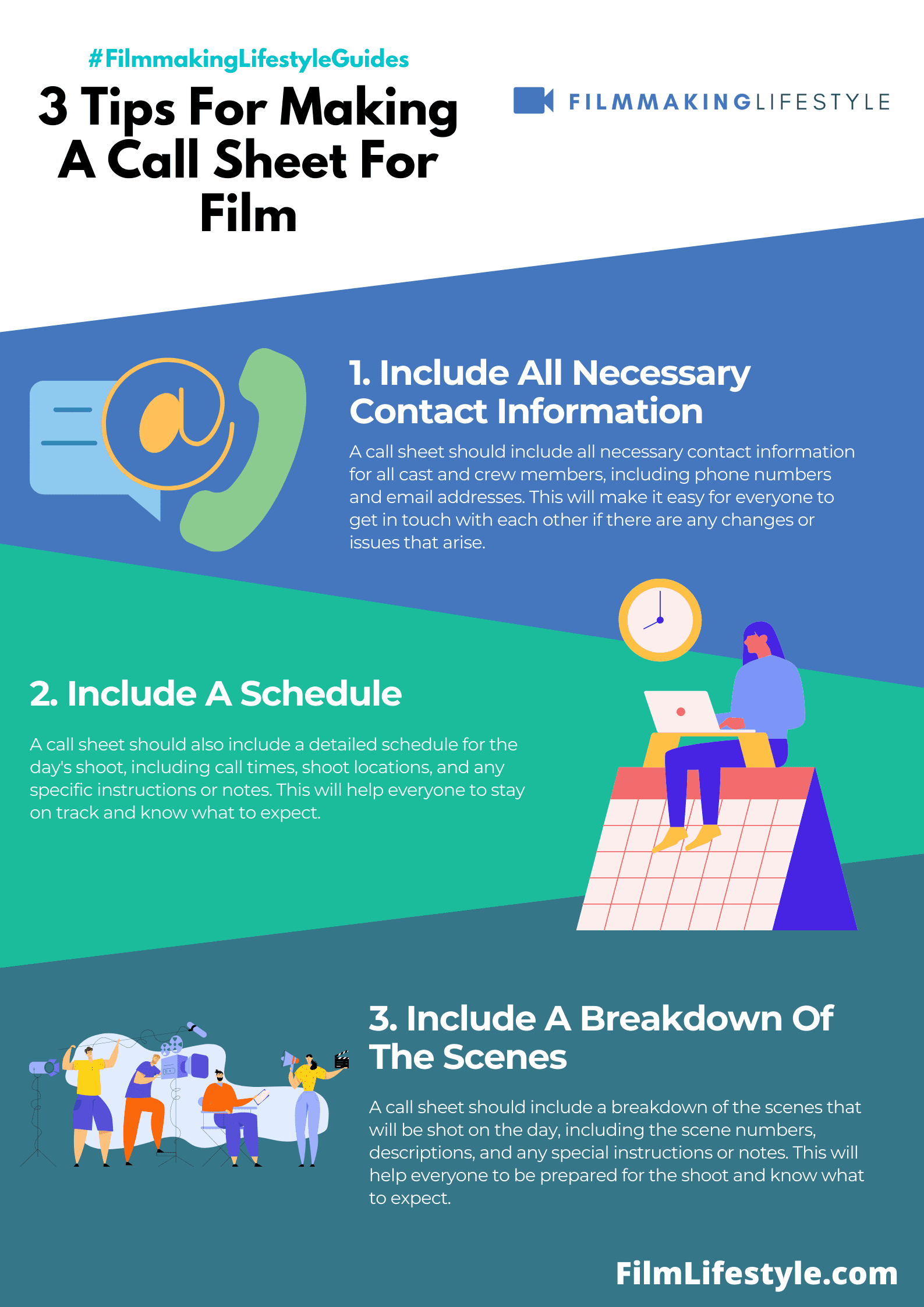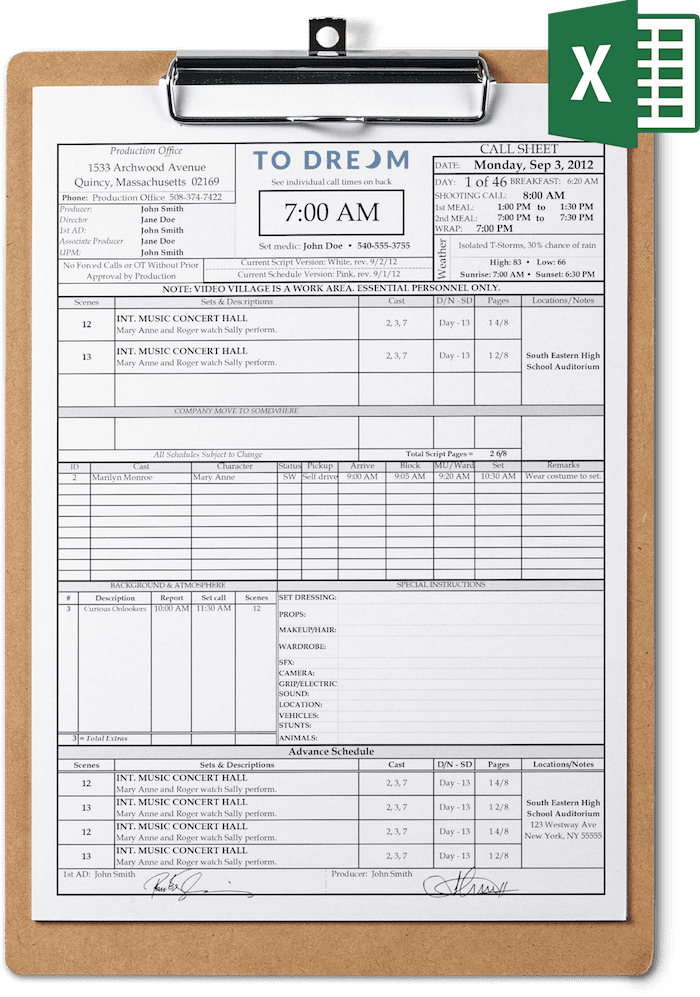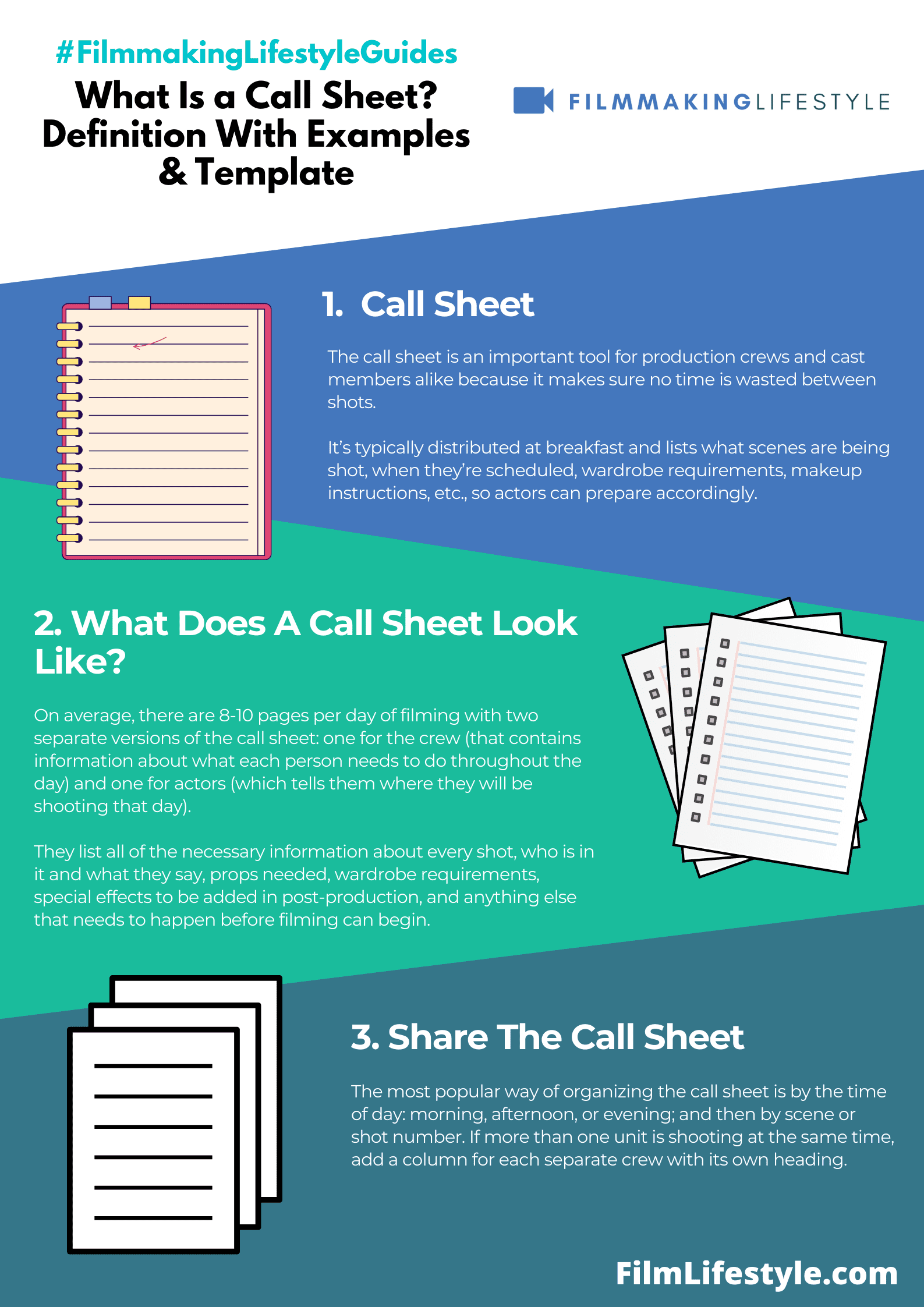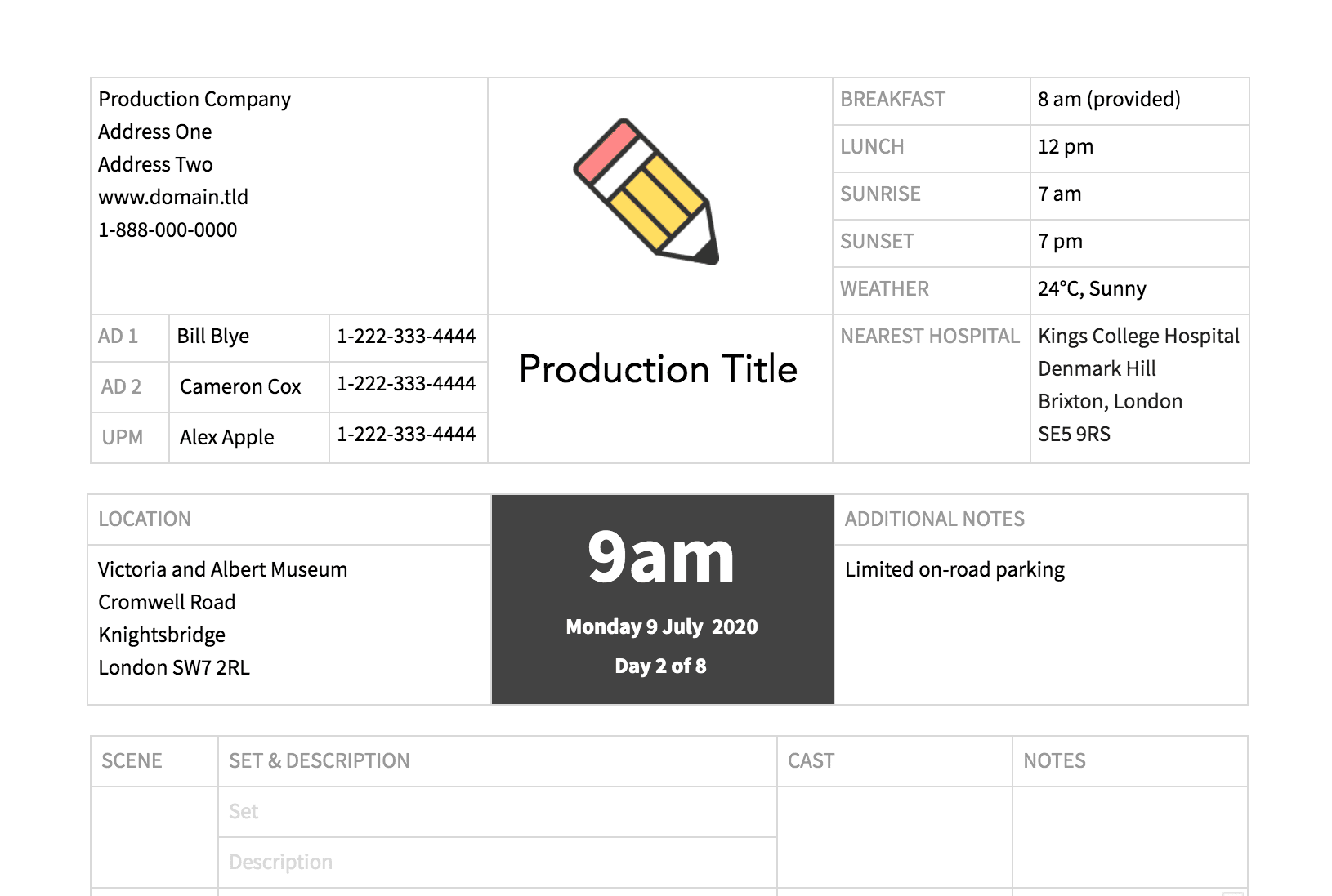A call sheet, in the simplest terms, is a weekly production schedule crafted by your Production Coordinator, with the director’s cut list. It outlines all the tasks an actor has to complete on set for a given day.
In this way, the Production Coordinator can more effectively manage their time, which is essential to delivering great work on time.
Call sheets also serve as an accountability tool, reminding everyone within the production that things are going according to plan.
WHAT IS A CALL SHEET
What Is a Call Sheet?
A call sheet is a document that outlines the shooting schedule for a production. It is typically used in film and television to list what scenes will be shot, when, where they are being filmed, and who will appear in them.
A call sheet may also include information about props needed, any special equipment required, or other relevant data such as location addresses or contact numbers.
In addition to providing essential details about the shoot itself, many producers believe that creating a well-organized call sheet can save money by cutting down on wasteful preparation time at the beginning of each day’s shoot.
Ever wondered how film crews stay on the same page during the chaotic ballet of a shoot day?
That’s where a call sheet comes into play.
It’s the daily docket that keeps everyone from the director to the extras in sync.
In this article, we’ll jump into the nuts and bolts of what a call sheet really is, why it’s the linchpin of production planning, and how it can make or break a day on set.
Stick with us as we peel back the curtain on this essential filmmaking tool.
What Is A Call Sheet
A call sheet is the backbone of daily film production.
It outlines the schedule and provides vital information for cast and crew.
This document is essential for maintaining organization and ensuring everyone is aware of their call times and locations.
Without it, the risk of miscommunication and delays rises significantly.
Organization and efficiency are key traits of a successful call sheet.
It should be easy to read and accessible to all members involved in the production.
Typically, a call sheet includes:
- Production Title – the name of the film or project,
- Date and Day – of the shoot within the production schedule,
- Call Time – when each cast and crew member needs to arrive,
- Locations – where the day’s filming will occur, with addresses and parking details,
- Scene Numbers and Descriptions – to provide context for the day’s work,
- Cast List – who will be needed and at what times,
- Crew Call – the departmental requirements for the day.
The role of the call sheet extends beyond a mere timetable.
It is the definitive source for contact information, hospital locations, weather updates, and other miscellaneous but crucial data.
This ensures that should any issues arise, solutions can be quickly implemented.
Advanced software tools are now aiding the creation of call sheets, resulting in sharper accuracy and distribution.
Yet, the heart of this document remains unchanged.
It is about anticipation and meticulous planning to keep the day’s shoot on track.
Call sheets also reflect the logistical prowess of the production team.
They detail transportation plans, special instructions, and safety protocols.
These elements are pivotal in creating a work environment that not only fosters creativity but also prioritizes the well-being of everyone on set.
The effectiveness of each shooting day relies heavily on the precision of the call sheet.
It brings harmony to the chaotic nature of filmmaking, syncing the efforts of various departments.
Through this logistical nexus, the puzzle pieces of production are brought together in unison.
The Importance Of A Call Sheet In Film Production
Call sheets aren’t merely documents; they’re the day’s battle plan for a film shoot.
Without them, the complex machine of film production can quickly grind to a halt.
They’re the first thing checked in the morning and a reference point throughout the day.
Let’s jump into the crucial role call sheets play in the seamless execution of a film’s shooting schedule.
Efficiency and Clarity drive a successful film set.
A well-crafted call sheet outlines who needs to be where, when, and for what purpose – this is non-negotiable for keeping the shoot on schedule.
Communication Is Critical – Call sheets bridge the gap between different departments.
They convey precisely what’s expected of everyone from the lead actor to the grip department.
To illustrate, here are what call sheets must articulate:
- Specific call times for cast and crew – Locations and set details,
- Scenes and shots to be captured,
- Updates on weather and schedule changes.
A film like The Lord of the Rings demonstrates the power of meticulous organization.
Such an expansive production depended on call sheets to coordinate vast numbers of cast and crew across numerous locations and complex scenes.
Call sheets are also accountability tools.
They ensure that every crew member is aware of their responsibilities and helps prevent costly miscommunications and delays.
Technology has revolutionized call sheet creation – digital tools allow for real-time updates and easy distribution.
This reflects the dynamic nature of film production, where adaptability is key.
In our experience, the rigor applied to call sheets can make or break a film.
They epitomize foresight and attention to detail, qualities integral to our craft in filmmaking.
As the sun rises on filming days, the call sheet mirrors the day’s potential.
We’re committed to perfecting this essential document, an unspoken hero in our stories’ successful telling.
Components Of A Call Sheet
Every call sheet serves as the blueprint for the day’s filming schedule and its contents are vital for a smooth operation.
We must understand each element to appreciate the role they play in a successful shoot.
Production Title and Logo – At the top, you’ll find the title of the production, often accompanied by the production company’s logo.
This helps to immediately identify the project, reinforcing brand recognition.
Date, Day Number, and Call Time – These details offer a clear snapshot of when the filming occurs.
It ensures everyone knows the exact day of production and the time they’re expected on set.
Locations and Addresses – It’s crucial that the locations are listed with accurate addresses.
Comprehension of the destination prevents tardiness and confusion which can lead to costly delays.
Key Contact Information – A section is dedicated to listing the contact details of crew members and department heads.
This facilitates efficient communication paths in case anyone needs to be reached urgently.
Schedule – Arguably the most critical section:
- Scenes to be shot,
- Location changes,
- Breaks (if applicable) The listed schedule acts as a guidepost for the flow of the day, steering the shoot toward its goals.
Cast Call Times – Individual call times for cast members ensure that they know when they’re due on set.
By staggering arrival times, we can manage on-set personnel effectively.
Crew Call Times – Similar to the cast, every crew member has a designated call time.
This helps in managing the flow of personnel throughout the day.

Advanced Schedule – For larger productions, a glimpse into upcoming shoot days is sometimes included.
It keeps everyone aligned on the trajectory of the production.
Safety Notices and Special Instructions – Guidelines on safety measures and any special instructions for the day are not to be overlooked.
These notes are essential for maintaining a secure working environment.
Hospital Proximity and Weather – Details on the nearest medical facility are provided for emergencies.
Knowledge of the day’s expected weather conditions can influence wardrobe decisions and shooting schedules.
Understanding these elements is foundational for anyone stepping onto a film set.
With every detail precisely outlined, the call sheet ensures that no aspect of production is left to chance.
How To Create A Call Sheet
Call sheets are crucial in ensuring a smooth day on set and there’s an art to creating one that’s both comprehensive and easy to follow.
To start, gather all the necessary information about the shoot day – this includes everything from scene requirements to personnel details.
Begin with the basics by listing the production title, date, day number out of the total shoot days, and the general call time.
Be sure to include the location addresses and any parking instructions to prevent on-the-day confusion.
The next step is to detail the shooting schedule.
Break down the scenes by time and location, specifying when and where each scene is to be shot.
If any scenes have specific requirements, like special effects or stunts, highlight them clearly.
For cast and crew, specific call times are a must.
Here’s what you should provide for each person:
- Name,
- Role or department,
- Individual call time,
- Necessary equipment or preparations.
Don’t forget to add key contact information.
This should include the names and numbers of the director, assistant directors, production office, and other crucial personnel.
Information about the nearest hospitals and the day’s weather report are essential for safety and planning.
These details help mitigate risks and allow the team to prepare adequately for any changes in weather.
Include any important safety notices or special instructions that will ensure the day runs without a hitch.
This could pertain to on-set etiquette or specific guidelines that the cast and crew need to follow.
focusing to these details, a call sheet can transform from a simple document to the backbone of a film set, guiding every member of the production towards a successful shoot day.
Tips For Using A Call Sheet Effectively
Efficiently using a call sheet is crucial for a productive day on the film set.
We know that it acts as a road map for the entire cast and crew, but its effectiveness hinges on how it’s utilized.
To maintain the momentum of the day, crew members should review their call sheets the night before.
This proactive approach allows for any questions to be addressed before arriving on set, saving valuable time.
It’s essential that the call sheet is accessible at all times.
We recommend that everyone keeps a digital copy on their phones, plus to physical copies on hand.
Communication is key – if there are any changes, make sure to notify everyone promptly.
A call sheet is only effective if it reflects the most up-to-date information.
Here are a few pointers to make the most out of your call sheet:
- Always triple-check the details before distributing,
- Highlight key information like call times and venue changes,
- Encourage cast and crew to report discrepancies immediately.
Designated point persons should be tasked with call sheet management.
These individuals will ensure that each department receives updates and comprehends their specific instructions.
Remember that a call sheet is also a tool for accountability.
It helps keep track of everyone’s tasks and facilitates in maintaining a professional atmosphere on set.
By adhering to these tips, we ensure that our call sheets are not just informational documents.
They become the cornerstone of our production efficiency, directly contributing to a smoother shoot.
What Is A Call Sheet – Wrap Up
We’ve shared our insights on the pivotal role of the call sheet in film production.
With our tips for utilizing call sheets to their fullest, we’re confident you’ll see a noticeable difference in your on-set efficiency.
Remember, it’s not just about having a call sheet—it’s about leveraging it as a dynamic tool to steer your production towards success.
Let’s embrace these practices and watch as they elevate our filmmaking process to new heights.
Frequently Asked Questions
What Is A Call Sheet In Film Production?
A call sheet is a document used in film production that outlines the schedule for a specific shooting day.
It includes essential details such as the cast and crew call times, locations, scenes to be shot, and contact information.
Why Is A Call Sheet Important?
A call sheet is crucial as it ensures that all cast and crew members are informed about when and where they are needed on set.
It serves as a central communication tool to coordinate the day’s shooting schedule and prevent misunderstandings and delays.
What Are Some Tips For Using A Call Sheet Effectively?
To use a call sheet effectively, review it the night before, keep it easily accessible, promptly communicate any changes, triple-check details before distribution, highlight key information, report any discrepancies found, and designate point persons for its management.
How Can A Call Sheet Improve Production Efficiency?
A well-managed call sheet serves as a tool for accountability, helps manage crew and cast expectations, and reduces the likelihood of errors or delays.
This contributes to a smoother shoot and overall production efficiency.
Should A Call Sheet Be Reviewed Beforehand?
Yes, reviewing the call sheet the night before the shoot can help to prepare for the upcoming day and identify any potential issues that might need addressing, ensuring a more organized production flow.





